Paolo Uccello
Paintings
The Battle of San Romano
Saint George and the Dragon
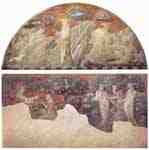
Santa Maria Novella : Frescoes in the cloister
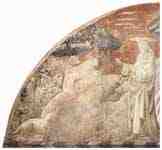
Santa Maria Novella : Creation of the Animals and Adam
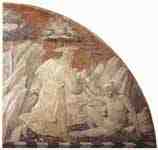
Santa Maria Novella : Creation of the Animals and Adam
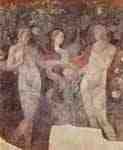
Santa Maria Novella : Creation of Eve and Original Sin
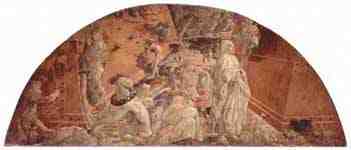
Santa Maria Novella : Flood and Noah's Ark
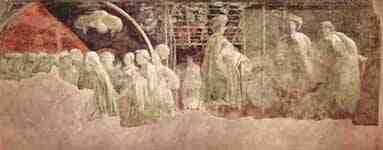
Santa Maria Novella : peace offerings, and drunkenness of Noah
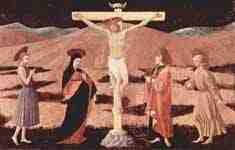
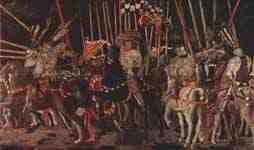
Battle of Romano : intervention by M. da Cotignola
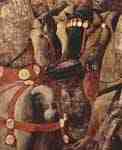
Battle of Romano : intervention by M. da Cotignola
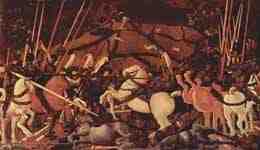
Battle of Romano : Bernardino della victory over Ciarda
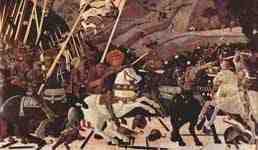
Battle of Romano : Niccolò da Tolentino as leader
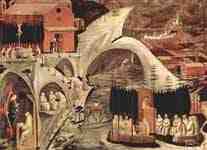
Episodes from the life of a hermit
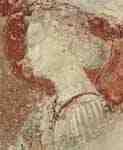

Cathedral of Prato : St. James of Todi
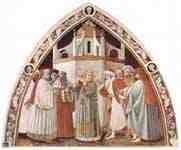
Cathedral of Prato : St. Stephan
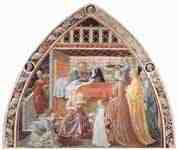
Cathedral of Prato : Nativity of Mary
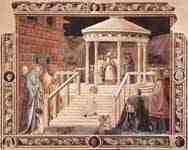
Cathedral of Prato : the Temple of Mary

Equestrian statue of Giovanni Acuto

Saints and two children , fragment
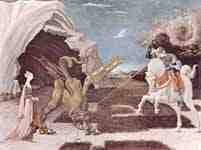
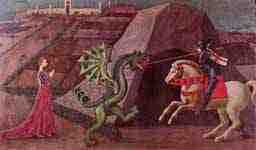
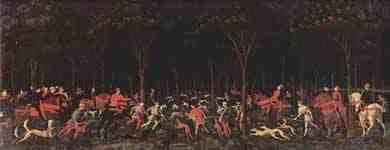


Quaranta altar : Adoration of the Magi
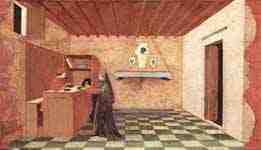
Predella panel to host miracle , scene
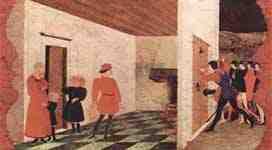
Predella panel to host miracle , scene
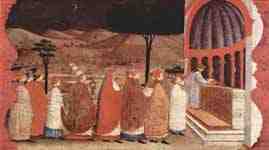
Predella panel to host miracle , scene
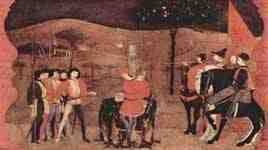
Predella panel to host miracle , scene
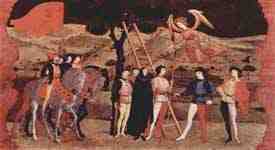
Predella panel to host miracle , scene
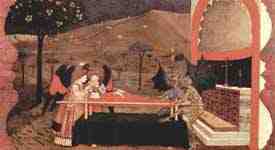
Predella panel to host miracle , scene
Drawings
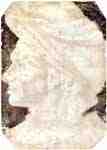
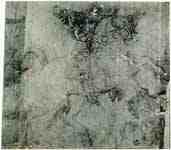
Knight with lance on horseback
Fine Art Prints | Greeting Cards | Phone Cases | Lifestyle | Face Masks | Men's , Women' Apparel | Home Decor | jigsaw puzzles | Notebooks | Tapestries | ...
Saint George and the Dragon
Paolo Uccello (Italian pronunciation: [ˈpaːolo utˈtʃɛlo]; 1397 – 10 December 1475), born Paolo di Dono, was an Italian painter and a mathematician who was notable for his pioneering work on visual perspective in art. Giorgio Vasari in his book Lives of the Artists wrote that Uccello was obsessed by his interest in perspective and would stay up all night in his study trying to grasp the exact vanishing point. He used perspective in order to create a feeling of depth in his paintings and not, as his contemporaries, to narrate different or succeeding stories. His best known works are the three paintings representing the battle of San Romano (for a long time these were wrongly entitled the "Battle of Sant' Egidio of 1416").
Paolo worked in the Late Gothic tradition, and emphasized colour and pageantry rather than the Classical realism that other artists were pioneering. His style is best described as idiosyncratic, and he left no school of followers. He has had some influence on twentieth-century art and literary criticism (e.g., in the "Vies imaginaires" by Marcel Schwob, "Uccello le poil" by Antonin Artaud and "O Mundo Como Ideia" by Bruno Tolentino).
Life
The sources for Paolo Uccello’s life are few: Giorgio Vasari’s biography, written 75 years after Paolo’s death, and a few contemporary official documents. Uccello was born in Pratovecchio in 1397.[1] His tax declarations for some years indicate that he was born in 1397, but in 1446 he claimed to be born in 1396.[2] His nickname Uccello came from his fondness for painting birds. His father, Dono di Paolo, was a barber-surgeon from Pratovecchio near Arezzo; his mother, Antonia, was a high-born Florentine.
At the age of ten, he was apprenticed to the famous sculptor Lorenzo Ghiberti, designer of the doors of the Florence Baptistery, whose workshop was the premier centre for Florentine art at the time. Ghiberti's late-Gothic, narrative style and sculptural composition greatly influenced Paolo. It was also around this time that Paolo began his lifelong friendship with Donatello. In 1414 Uccello was admitted to the painters' guild Compagnia di San Luca and just one year later, in 1415, he joined the official painter's guild of Florence Arte dei Medici e degli Speziali. By the mid 1420s the young Uccello probably left Ghiberti's workshop. He stayed on good terms with his master and may have been privy to the designs for Ghiberti's second set of Baptistery doors, The Gates of Paradise. These featured a battle scene, "that might well have impressed itself in the mind of the young Uccello ", and thus influenced The Battle of San Romano.[3]
According to Vasari, Uccello’s first painting was a Saint Anthony between the saints Cosmas and Damianus, a commission for the hospital of Lelmo. Next he painted two figures in the convent of Annalena. Shortly afterwards he painted three frescoes with scenes from the life of Saint Francis above the left door of the Santa Trinita church. For the Santa Maria Maggiore church he painted a fresco of the Annunciation. In this fresco, he painted a large building with columns in perspective. Vasari writes that people thought this was a great and beautiful achievement.
Paolo painted the Lives of the Church Fathers in the cloisters of the church of San Miniato, on a hill overlooking Florence. For this fresco he used unusual colours (blue pastures, red bricks and different colours for the buildings) as a protest against his monotonous meals served by the abbot: cheese pies and cheese soup. In the end Paolo felt so miserable that he ran away. He only finished the job after the abbot promised to serve him normal meals.
Uccello was asked to paint a number of scenes of distempered animals for the house of the Medici. His depiction of a fierce lion fighting with a venom-spouting snake was especially appreciated by Vasari. Uccello loved to paint animals and he kept a large number of pictures of all kinds of animals, especially birds, at home. Because he was so fond of birds, he was aptly nicknamed Paolo Uccelli (Paul of the birds).
By 1424 Paolo was earning his own living as a painter. In that year he painted episodes of the Creation and expulsion for the Green Cloister (Chiostro Verde) of Santa Maria Novella in Florence (now badly damaged), proving his artistic maturity. Again, he was able to paint in a lively manner a large number of animals. As he succeeded in painting trees in their natural colours, in contrast with many of his predecessors, he began to acquire a reputation for painting landscapes. He continued with scenes from the Deluge, the story of Noah's Ark, Noah's sacrifice and Noah's drunkenness. These scenes brought him great fame in Florence.
Around this time he was taught geometry by Antonio Manetti.
Funerary Monument to Sir John Hawkwood
In 1425, Uccello travelled to Venice, where he worked on the mosaics for the façade of San Marco (all these works have been lost). Some suggest he visited Rome with his friend Donatello before returning to Florence in 1431. He also painted some frescoes in the Prato Cathedral and Bologna.
In 1432 the Office of Works asked the Florentine ambassador in Venice to enquire after Uccello’s reputation as an artist. Uccello remained in Florence for most of the rest of his life, executing works for various churches and patrons, most notably the Duomo. In 1436 he was given the commission for the monochromatic fresco of Sir John Hawkwood. In this equestrian monument he showed his keen interest in perspective. The condottiere and his horse are presented as if the fresco was a sculpture, seen from below.
If, as is widely thought, he is the author of the frescoes Stories of the Virgin and Story of Saint Stephen in the Cappella dell'Assunta, Florence, then he would have visited nearby Prato sometime between 1435 and 1440. In 1443, he painted the figures on the clock of the Duomo. In the same year and in 1444 he designed a few stained glass windows for the same church. In 1444 he was also at work in Padua, and he travelled to Padua again in 1445 at Donatello’s invitation.
Saint George and the Dragon (c. 1470), showing Uccello's Gothic influences.
Back in Florence in 1446, he painted the Green Stations of the Cross, again for the cloister of the church Santa Maria Novella. Around 1447–1454 he painted Scenes of Monastic Life for the church San Miniato al Monte, Florence.
Around 1450–1456 he painted his three most famous paintings The Battle of San Romano, the victory of the Florentine army over the Sienese in 1432, for the Palazzo Medici in Florence. The extraordinarily foreshortened forms extending in many planes accentuate Uccello's virtuosity as a draftsman, and provides a controlled visual structure to the chaos of the battle scene.
The Battle of San Romano, c. 1438–1440. Egg tempera with walnut oil and linseed oil on poplar. 181.6 x 320 cm. Uffizi.
Uccello was married to Tommasa Malifici by 1453, because in that year Donato (named after Donatello) was born, and in 1456 his wife gave birth to Antonia.[4]
In 1465, Uccello was in Urbino with his son Donato, where he was engaged until 1469, working for the Confraternity of Corpus Domini, a brotherhood of laymen. He painted the predella for their new altarpiece with the Miracle of the Profaned Host. (The main panel representing the "Communion of the Apostles" was commissioned to Justus van Ghent and finished in 1474.) Uccello's predella comprises six meticulous, naturalistic scenes related to the antisemitic myth of host desecration, based on a supposed event in Paris in 1290. It has been suggested that the subject of the main panel, on which Duke Frederick of Montefeltro of Urbino appears in the background conversing with an Asian, is related to the antisemitic intention of the predella. Federico allowed a small Jewish community to live in Urbino.[5] Not all these scenes are unanimously attributed to Paolo Uccello.
A scene in Paolo Uccello's Corpus Domini predella (c. 1465-1468), set in a Jewish pawnbroker's home. Blood in the background emanates from the Host, which the moneylender has attempted to cook, and seeps under the door. This story first entered the Italian literary tradition via Giovanni Villani (c. 1280–1348) and his Nuova Cronica.
In his Florentine tax return of August 1469 he declared: “I find myself old and ailing, my wife is ill, and I can no longer work.” In his last years, he was a lonesome, forgotten man, afraid of hardship in life. His last known work is The Hunt, c. 1470. He made his testament on 11 November 1475 and died shortly afterwards at the age of 78 on 10 December 1475 at the hospital of Florence. He was buried in his father’s tomb in the Florentine church of Santo Spirito.
With his precise, analytical mind he tried to apply a scientific method to depict objects in three-dimensional space. In particular, some of his studies of the perspective foreshortening of the torus are preserved, and one standard display of drawing skill was his depictions of the mazzocchio.[6] The perspective in his paintings has influenced famous painters such as Piero della Francesca, Albrecht Dürer and Leonardo da Vinci, to name a few.
His daughter Antonia Uccello (1456–1491)[7] was a Carmelite nun, whom Giorgio Vasari called "a daughter who knew how to draw". She was even noted as a "pittoressa", a painter, on her death certificate. Her style and her skill remains a mystery as none of her work is extant.
Works
Pope-Hennessy is far more conservative than the Italian authors: he attributes some of the works below to a "Prato Master" and a "Karlsruhe Master". Most of the dates in the list (taken from Borsi and Borsi) are derived from stylistic comparison rather than from documentation.
Clock in the Duomo, Florence.
Marble mosaic showing a small stellated dodecahedron and a ring of hexagonal prisms, on the floor of St Mark's Basilica, Venice.
Annunciation (c. 1420–1425) - Ashmolean Museum, Oxford
Creation and Fall (c.1424–1425) - Lunette and lower section, Chiostro Verde, Santa Maria Novella, Florence
Adoration of the Magi (c. 1431–1432) - Staatliche Kunsthalle, Karlsruhe
St George and the Dragon (c. 1431) - National Gallery of Victoria, Melbourne
Quarate Predella (c. 1433) - Museo diocesano di Santo Stefano al Ponte, Florence
Frescoes in the Capella dell' Assunta (c. 1434–1435) - Duomo, Prato
Nun-Saint with Two Children (c.1434–1435) - Contini-Bonacosi Collection, Florence
Funerary Monument to Sir John Hawkwood (c. 1436) - Duomo, Florence
The Battle of San Romano, consisting of:
Battle of San Romano: Niccolò da Tolentino (c. 1450–1456) - National Gallery, London
Battle of San Romano: Bernadino della Ciarda unhorsed (c. 1450–1456) - Galleria degli Uffizi, Florence
Battle of San Romano: Micheletto da Cotignola (c.1450) - Musée du Louvre, Paris
St George and the Dragon (c. 1439–1440) - Musée Jacquemart-André, Paris
Clock Face with Four Prophets/Evangelists (1443) - Duomo, Florence
Resurrection (1443–1444) - stained glass window, Duomo, Florence
Nativity (1443–1444) - stained glass window, Duomo, Florence
Story of Noah (c. 1447) - lunette and lower section, Chiostro Verde, Santa Maria Novella, Florence
Scenes of Monastic Life (c. 1447–1454) - S. Miniato al Monte, Florence
Saint George and the Dragon (c. 1450-55) - National Gallery, London
Crucifixion (c. 1457–1458) - Thyssen-Bornemisza Collection, Madrid
Life of the Holy Fathers (c. 1460–1465) - Accademia, Florence
Miracle of the Profaned Host (1467–1468) - predella, Galleria Nazionale delle Marche, Palazzo Ducale, Urbino)
The Hunt in the Forest (c. 1470) -- Ashmolean Museum, Oxford
References
Private Life of a Masterpiece, BBC TV
Borsi, Franco & Stefano. Paolo Uccello. pp. 15, 34. London: Thames & Hudson, 1994.
Private Life of a Masterpiece BBC TV
Oxford Art Online
Katz, Dana E., The contours of tolerance: Jews and the Corpus Domini Altarpiece in Urbino The Art Bulletin:85 (December 2003)
Emmer, Michele. "Art and Mathematics: The Platonic Solids." Leonardo 15(4): 277-282 (Autumn, 1982).
Echols, Anne; Marty Williams. An annotated index of medieval women. Markus Wiener Publishers, 1992, p. 61. ISBN 0-910129-27-4
Sources
Giorgio Vasari's life of Paolo Uccello translated by George Bull in Lives of the Artists, Part 1. Penguin Classics, 1965.
D'Ancona, Paola. Paolo Uccello. New York: McGraw Hill, 1961.
Barolsky, Paul. "The Painter Who Almost Became a Cheese" Virginia Quarterly Review, 70/1 (Winter 1994).
Borsi, Franco & Stefano. Paolo Uccello. London: Thames & Hudson, 1994. (a massive monograph)
Borsi, Stefano. Paolo Uccello. Art Dossier. Florence: Giunti, nd.
Roberto Manescalchi, Paolo Uccello: un affresco dimenticato?, Grafica European Center of Fine Arts, Firenze 2006. ISBN 978-88-95450-19-3
Carli, Enzo. All the Paintings of Paolo Uccello. The Complete Library of World Art. London: Oldbourne, 1963. (originally published in Italian in the 1950s)
Paolieri, Annarita. Paolo Uccello, Domenico Veneziano, Andrea del Castagno. Library of Great Masters. New York: SCALA/Riverside, 1991.
Pope-Hennessy, John. Paolo Uccello: Complete Edition. 2nd ed. London: Phaidon, 1969. (the other important English-language monograph)
Marilyn Aronberg Lavin (1967). "The Altar of Corpus Domini in Urbino: Paolo Uccello, Joos Van Ghent, Piero della Francesca". Art Bulletin 49 (1): 1–24. doi:10.2307/3048425. JSTOR 3048425.
Wikisource has the text of the 1913 Catholic Encyclopedia article Uccello.
This article incorporates text from a publication now in the public domain: Herbermann, Charles, ed. (1913). "Paolo Uccello". Catholic Encyclopedia. Robert Appleton Company.
----
Fine Art Prints | Greeting Cards | Phone Cases | Lifestyle | Face Masks | Men's , Women' Apparel | Home Decor | jigsaw puzzles | Notebooks | Tapestries | ...
----
Artist
A - B - C - D - E - F - G - H - I - J - K - L - M -
N - O - P - Q - R - S - T - U - V - W - X - Y - Z
Retrieved from "http://en.wikipedia.org/"
All text is available under the terms of the GNU Free Documentation License




